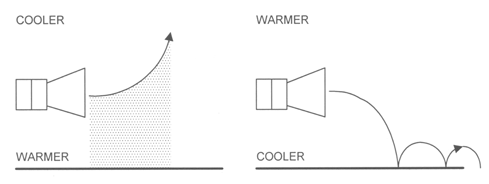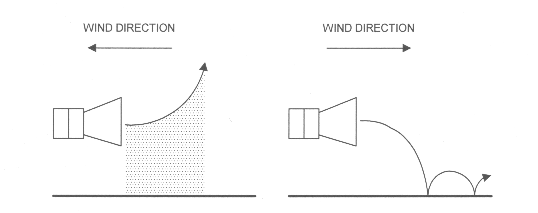![]() BACK TO ourHealdsburg.com
BACK TO ourHealdsburg.com
![]() BACK to NOISE page
BACK to NOISE page
Developing a new Healdsburg Noise Ordinance
![]()
Outdoor Sound Transmission and Control
![]()
OUTDOOR SOUND Transmission and Control
Sound transmission outdoors, especially over distances greater than 200 to 300 feet from a sound source, is highly dependent on weather conditions. The atmospheric conditions that affect sound travel the most are temperature variations, inversion layers, wind currents, and humidity. Atmospheric turbulence can randomize sound so that the interference effects resulting from combinations of sound paths are reduced. Higher frequency sound is absorbed by air depending on the exact temperature and relative humidity of the air (Crocker & Price 1975; Ford 1987). Because there are many complex effects, it is not usually possible to accurately predict sound pressure levels at large distances from a source.
For temperature variations, sound waves generally bend toward cooler temperatures. For example, with all other weather conditions remaining unchanged, on a typical summer’s afternoon, air temperature decreases with increasing altitude. In this case, sound waves tend to bend upward. They create a "shadow zone". If you are in a shadow zone, you may be able to see a sound source at a distance but not hear it. Shadow zones can decrease sound levels by up to 20 dB(A) at distances greater than 500 feet from a sound source. Shadow zones can occur when sound travels against the wind.
These conditions are reversed when temperatures are lower close to the ground, as in the early morning or over a calm body of water. In this case, sound waves tend to bend toward the ground, bounce off of the ground, and travel farther than normal. This is why sound is said to "carry" well over water. Sound also travels farther when in the direction of the wind.

Figure 1 Sound Travel in Temperature Variations

Figure 2 Sound Travel in Wind Currents
Sound Level And Distance From The Source = Most people know that noise levels increase as you get closer to a sound source and decrease as you move away.
It is important to note that the sound pressure level rises at a faster rate as you move closer and at a slower rate as you move away. Think about what happens when you drop a stone in water. The waves that are created are closer together and higher (amplitude) nearer the point of impact and further apart and lower as you move away from where the stone entered the water. Sound pressure behaves in the same manner.
Outdoor Sound Control
Sound can be controlled either at its source, in the path between the source and the listener, or at the listener's location.
Although there are many options to attenuate noise sources indoors, options are much more limited outdoors. We are limited to either erecting some type of barrier between the noise source and listener, or creating some type of buffer zone in the same area. Barriers must be solid, such as some type of wall or earth berm. Fences and/or vegetation provide minimal sound reduction. Bear in mind, however, that even the most effective barriers only provide 15 to 20 dB(A) of noise reduction because a significant amount of sound energy travels over and around barriers. Another limitation of outdoor barriers is that they are only effective within distances of roughly 200 to 300 feet. If the distance between a noise source and a listener is greater than 300 feet, a barrier will typically be ineffective.
Syar Sand and Gravel Plant Outdoor Sound Conditions
Sound transmission outdoors is highly dependent on weather conditions including temperature, humidity and wind. Syar's Sand and Gravel plant is next to the Russian river,
(ideal for sound reflection, see aerial photo), it has no physical sound barriers, and frequent winds from the south create ideal conditions for broadcasting noise and dust. Syar claims they have "berm" walls. In reality these are temporary winter stockpiles of sand and gravel mined from the river. These piles are on the West side of the plant and are depleted in a few months. Also because these "walls" are not continuous the sound from the loaders and trucks passes around them. [Syar Sand and Gravel plant equipment]
Reflections
MORE TO COME
![]()
![]()
![]() BACK TO ourHealdsburg.com
BACK TO ourHealdsburg.com
![]() BACK TO ourHealdsburg.com NOISE page
BACK TO ourHealdsburg.com NOISE page
webmaster:
![]() thomasjoad@ourHealdsburg.com
thomasjoad@ourHealdsburg.com
© 2002 ourHealdsburg.com™. All rights reserved.